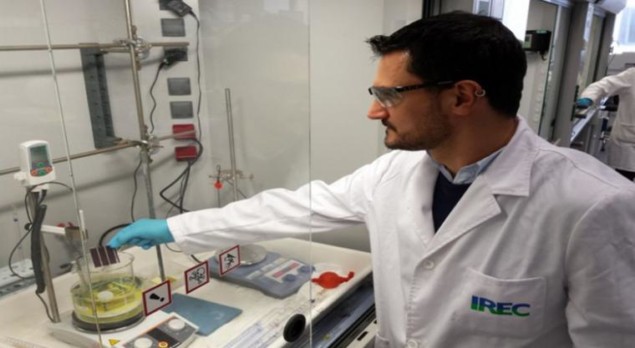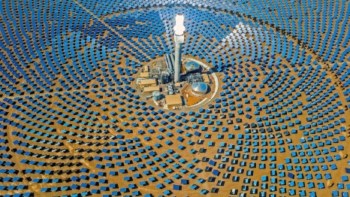As the first ever table of efficiencies for emerging photovoltaic technologies is published in Journal of Physics: Energy, Edgardo Saucedo, an investigator at the Catalonia Institute for Energy Research, talks to Anna Demming about the motivation and strategy behind it.

What was the motivation behind publishing this table of efficiencies?
Ten years ago the search for new materials that can bring additional advantages with respect to those we already have, started to gain momentum. These materials might be used on flexible or transparent substrates or are formed exclusively from elements that are very abundant or very cheap. So many groups started to work on these materials.
The situation right now is that we have many emerging materials that are not summarized very well anywhere. There is a paper – very similar to ours – tabling the progress in conversion efficiency in very well established technologies. That table is published every six months [since 1993] in Progress in Photovoltaics by Wiley, however it is limited to technologies at the industrial stage. Our idea was to put together all these emerging technologies that are not considered in the other papers, so that the community can follow all these sometimes very complex and diverse materials and identify the most promising ones.
I had been thinking of doing something like this for two to three years – in part it was out of frustration. We work with new materials, so we try to be at the forefront and stay very up to date on the materials that are most relevant in the future, but it is very frustrating to get this information because it takes such a lot of time. We are researchers and have to dedicate our time to research projects – justifying projects, applying for projects and supervising theses – and to have this simplification in our lives should be very useful.
For this first edition we are seven authors – two from north America, two from Europe and two from Asia and we asked Aron Walsh to give a review of modelling these materials.
What led you to include the review?
This is the difference between our efficiency table and the table for photovoltaics already published every six months. Because it is a very dynamic field with new efficiencies and new materials every month or so, to have a section in the paper that contemplates what we consider to be very relevant at the time of publishing is very useful for readers. So it is a short section – not enough to be a topical review in itself, but a highlight of the year for emerging technologies.
This time we decided to include a section overviewing modelling. Because these materials are very new, modelling is very important to understand the properties. There are a lot of things to work on and we are waiting for theoreticians to give us input as to what might be useful or interesting to do in the lab. The idea is to publish a new edition each year and in the next edition to invite other scientists who will review topics that are very new and emerging in photovoltaics.
How did you decide on the scope?
We decided to limit these efficiency tables to inorganic materials because the technologies for these materials are normally quite similar and easier to compare. The organic compounds or hybrid compounds are also of course beautiful, very relevant and very important but they use different device structures, different contacting layers, and different configurations. Even the physics behind all the devices can be quite different. So it is more difficult to cross link all these materials. As a result, we focus our attention on the inorganic compounds.
Even in inorganic materials we have a lot of materials to analyse – but on the organic side there are probably even more. In the future it may interesting for the journal to produce something similar for organic or hybrid materials [but with specialists in those materials].
I have always worked with inorganic materials. I did my PhD thesis in a material that is quite relevant to energy applications – CdTe. Back then I was working on it for a different application – nuclear energy – but I had interactions with other groups who were working on it for solar energy, and this really caught my attention. So when I finished my PhD thesis, and my interest in renewable energy increased, I found a post doc position in this field in France. There I developed all my knowledge in thin film semiconductors for photovoltaic applications. I have now been working on this class of materials for energy applications for 14 years.
What led you to limit the table to devices with certified efficiencies and a minimum area?
Certification is very important and very common for materials at commercial stage, but not for emerging materials. So the first message we wanted to give to the scientific community is that it is very relevant to certify our devices even if the efficiency is not as high as we want or is in the range of 5–10%. It is very important to certify because it gives an extra level of confidence for other researchers.
In terms of area we try to use an area that is representative of other devices. Sometimes you can’t measure the area because it is quite difficult to exactly define it for certain architectures. However in solar cells with very small areas you can have some collection from solar cells that are close by. If your solar cell is big enough this is negligible but when you reduce the size a lot it is hard to distinguish whether all the current you are obtaining is from your solar cell or if you have an important contribution from the neighbouring solar cells, so you can get mistakes.

The search for silicon’s successor
There are also what we call “notable exceptions” [devices in the table that do not meet the efficiency and area criteria]. These are the result of brainstorming among the authors. We based them on what parameters we can really be sure about and trust, and parameters with limited error, as this can be very big, more than 10% for example. So it was based on our experience and consultation with people with more expertise than us in metrics for photovoltaics modules.
You plan to publish new tables each year – sounds like a lot of work.
It was a lot of work for six people over several months to do the first table – and we are very familiar with these materials. This year is the first and we have developed a methodology. In principle we expect it to be easier in future years. Each author has a particular group of materials and each of us is following materials that are quite related to what we are doing in the lab, so we are used to staying up to date on developments in them.
What might future editions feature?
We work in a democracy and will decide altogether what to include and what the highlight of emerging technologies should be. But I will propose either the full inorganic perovskite compounds or low dimensional, 1 or 2D compounds. They are emerging fast with very nice progress and very nice results.
The full table can be found in Journal of Physics: Energy



